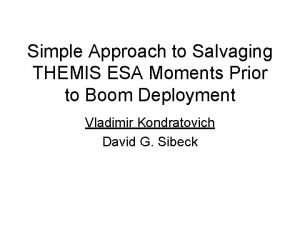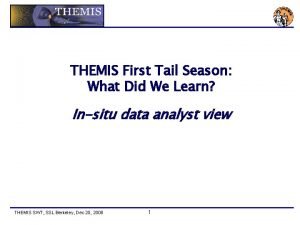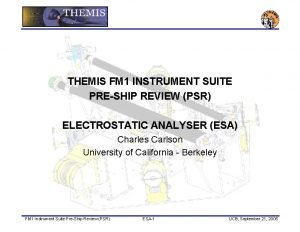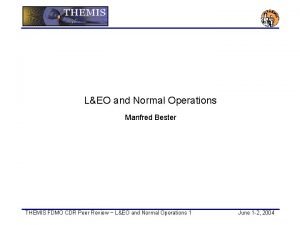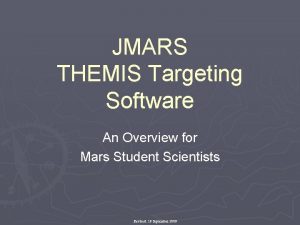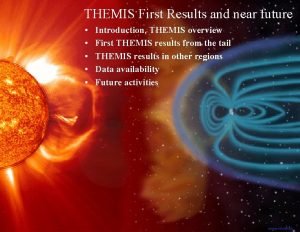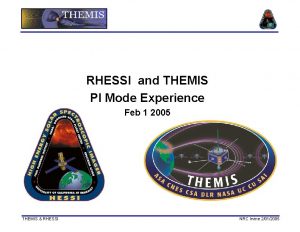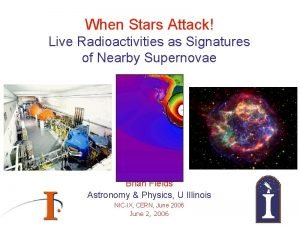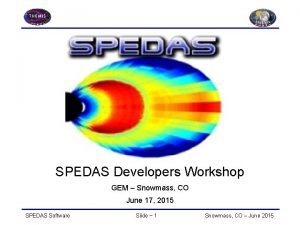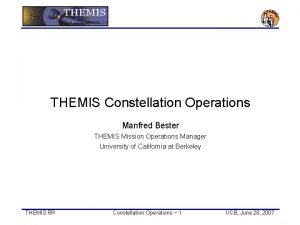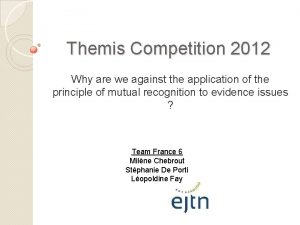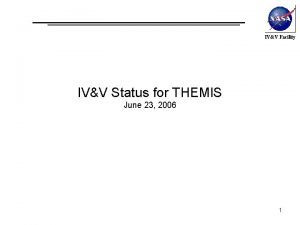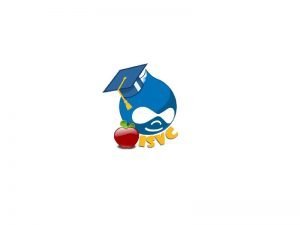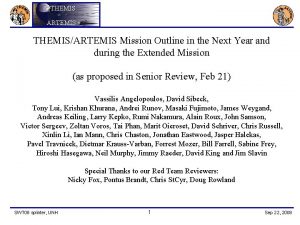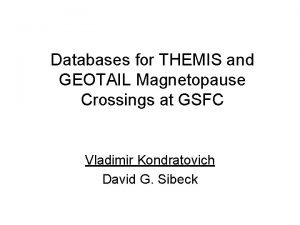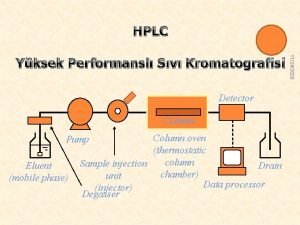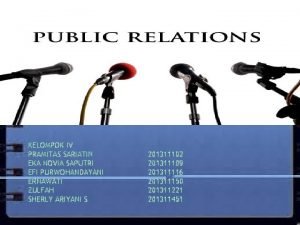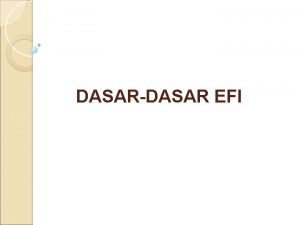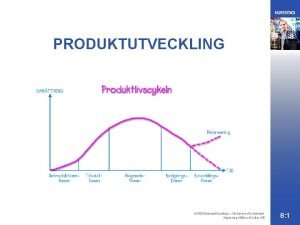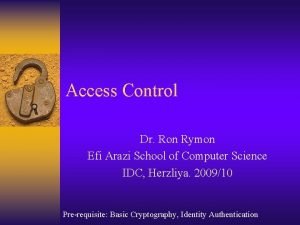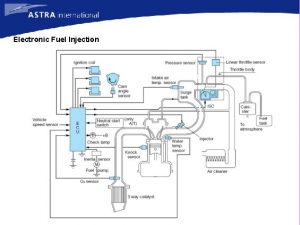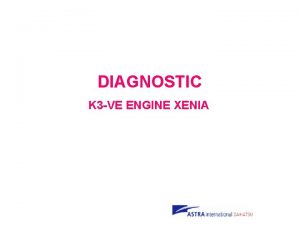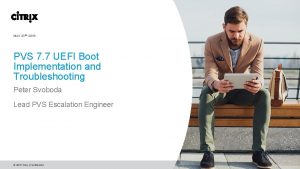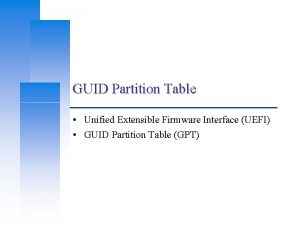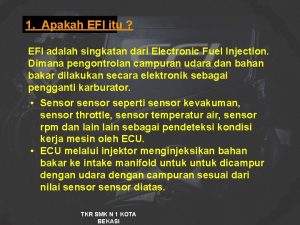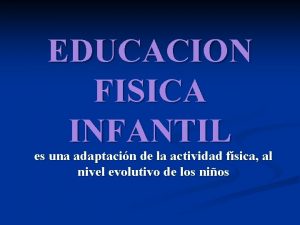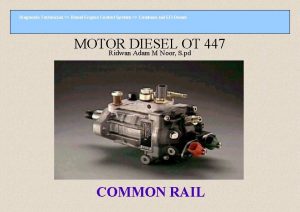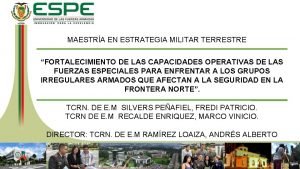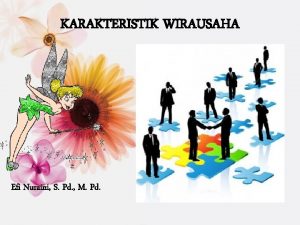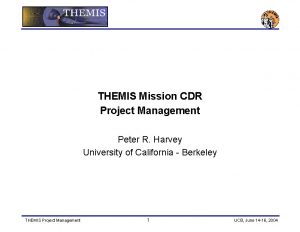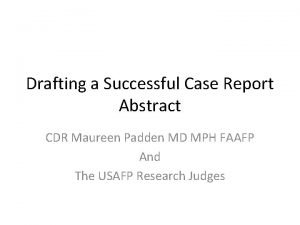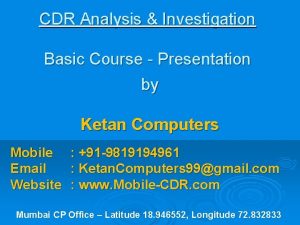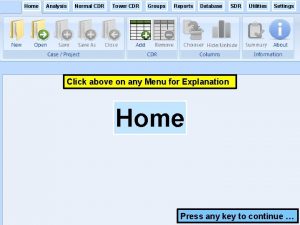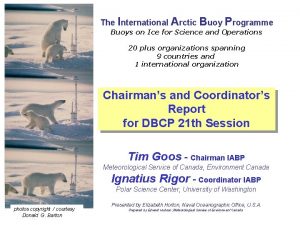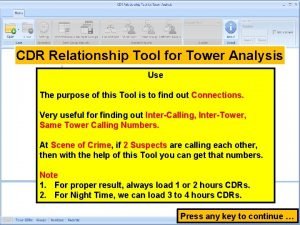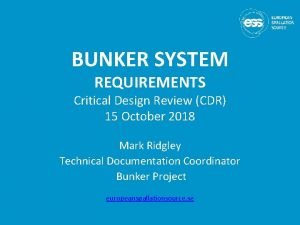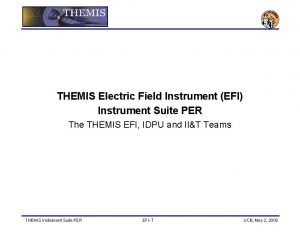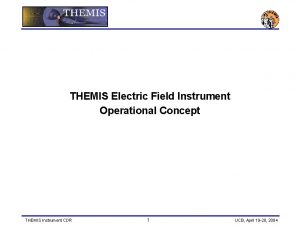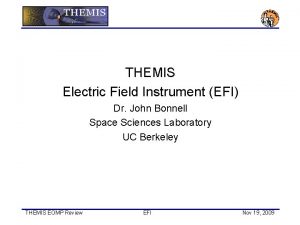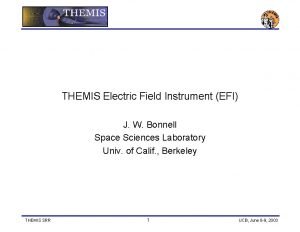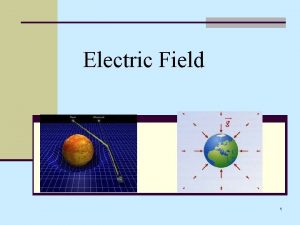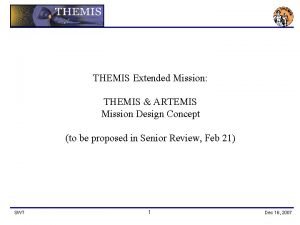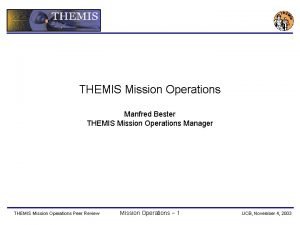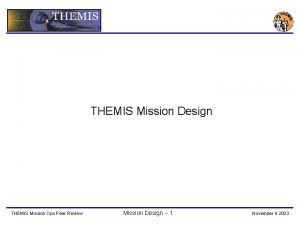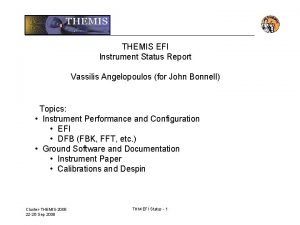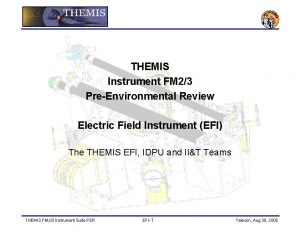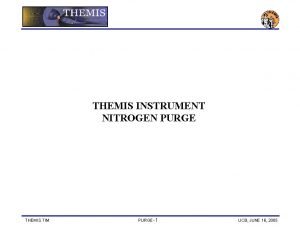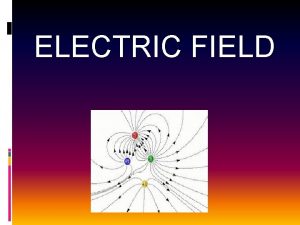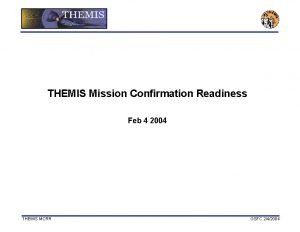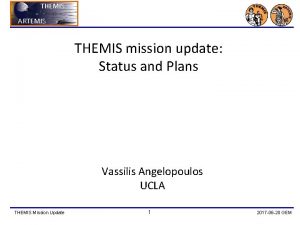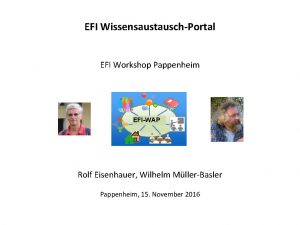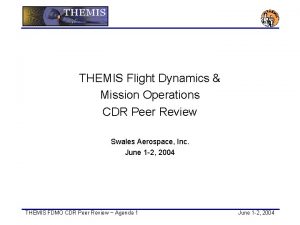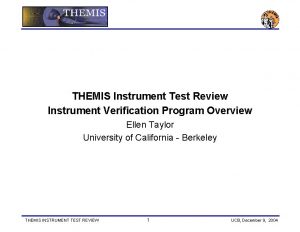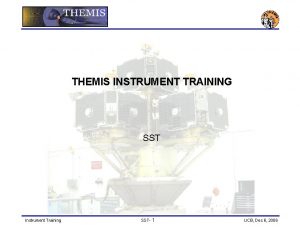THEMIS Electric Field Instrument EFI Mission CDR The
























































- Slides: 56

THEMIS Electric Field Instrument (EFI) Mission CDR The THEMIS EFI Team THEMIS Mission CDR EFI-1 UCB, June 14 -18, 2004

Outline • Personnel and Organization • Summary of EFI Status at MCDR • Requirements, Specifications, and Design Compliance • Requirements • Top-Level Design • Error Budgets • Status of Subsystem Design, Fabrication, and Testing • Fabrication, Integration, and Test • Schedule: Henry Ford Help Us… • Operations Planning • Deploy and Commisioning • Etc. THEMIS Mission CDR EFI-2 UCB, June 14 -18, 2004

Personnel and Organizational Chart (all UCB unless noted): • • • • Prof. F. Mozer (EFI Co-I). Drs. J. Bonnell, G. Delory, A. Hull (Project Scientists) P. Turin (Lead ME), Dr. D. Pankow (Advising ME) B. Donakowski (EFI Lead ME, SPB, Facilities) G. Dalton (SPB, EFI GSE ME), K. Mc. Kee (ME), S. Martin (MT) R. Duck (AXB ME) D. Schickele (Preamp, Sensor Cables, Facilities ME) S. Grimmer, R. Gupta (ME GSRs) S. Jelinsky, S. Marker (Facilities and TVAC Staff) S. Harris (BEB Lead EE), H. Richard (BEB EE) J. Lewis, F. Harvey (GSE) Technical Staff (H. Bersch, Y. Irwin, H. Yuan, B. Dalen, N. Castillo) Wm. Greer (UCLA), et al. ) R. Ergun (DFB Co-I; CU-Boulder) J. Westfall, A. Nammari, K. Stevens (DFB Sys. E, EEs; CUBoulder) C. Cully (DFB GSR; CU-Boulder) THEMIS Mission CDR EFI-3 UCB, June 14 -18, 2004

EFI Status at I-CDR • Requirements and Design: – – – • The current EFI design meets Mission and Instrument requirements. The design is complete. One new requirement (CG positioning) has been imposed post-PDR. Procurement: – All long-lead items have been procured in sufficient quantities to allow for ETU and initial FLT production: – – – • Personnel: – Team is complete: – – • EEE parts ordered; rad testing of required parts complete. SPB and AXB mechanical items (custom wire cable, stacers, actuators, motors) are in-house, or on order with expected delivery on schedule for FLT build up. FLT machining on order, with expected 25% fulfilment (1 -1/2 SC of parts) by early July, and remainder by end of July. All design engineering positions filled. One FT MT position filled Mar ’ 04; 0 ne PT MT positions filled internally by personnel transitioning over from STEREO; two ME GSRs hired for summer and fall to support FLT production startup. Assembly and Test: – – THEMIS Mission CDR ETUs of all major elements have been assembled and partially or largely tested. Testing will be completed by July 2004. EFI-4 UCB, June 14 -18, 2004

RFA and Design Trade Closure • RFAs from I-PDR, M-PDR, and I-CDR all responded to a/o closed out: – – • ESC Spec is on Rev. D 1; includes detailed specs on the requirement and methods to achieve it; ESC roster developed in Feb ’ 04, allowing close collaboration between Swales and UCB on problem areas and mitigation techniques. EMI Spec completed Mar ’ 04. Detailed Instrument I&T plan under development as part of ETU Testing; synthesized from Polar, Cluster, etc. Mechanical (INST-RFA 13, 14, 15, 19, 20, R 03), and Electrical (INST-RFA 16 AB, 17) arising from ICDR, as well as Internal Mechanical Review. Open Design Trades from PDR closed out: – – – THEMIS Mission CDR Boom lengths set at 50/40/7. 67 meters tip-to-tip based on CBE of Probe mass properties and std. GSFC and UCB dynamic stability requirements and boom mode resonance keep-outs. Ti-N chosen over DAG-213 for SPB sensor coating. Heritage brushed motor chosen for SPB deploy. Braid biasing selected, and Distal Braid length set at 3 m. DAC implementation on BEB chosen (ADC 5544), and bias offset range of +/40 V maintained. EFI filters on DFB chosen to be Bessel-type. EFI-5 UCB, June 14 -18, 2004

Mission Requirements REQUIREMENT EFI DESIGN IN-1. The Instrument Payload shall be designed for at least a two-year lifetime. Compliance. Lifetime has been considered in all aspects of EFI and DFB design (parts, performance degradation, etc. ). IN-2. The Instrument Payload shall be designed for a total dose environment of 33 krad/year (66 krad for 2 year mission, 5 mm of Al, RDM 2) Compliance. Common Parts Buy for Instrument Payload. All parts screened for total dose. Radiation testing planned if TID is unknown. IN-3. The Instrument Payload shall be Single Event Effect (SEE) tolerant and immune to destructive latch-up. Compliance. Common Parts Buy for Instrument Payload. All parts screened for total dose. Radiation testing planned if LET is unknown. THEMIS Mission CDR EFI-6 UCB, June 14 -18, 2004

Mission Requirements REQUIREMENT EFI DESIGN IN-7. No component of the Instrument Payload shall exceed the allocated mass budget in THM-SYS-008 THEMIS System Mass Budget. xls Compliance. SPB: 1. 88 kg Allocated; 1. 61 kg CBE (CAD model). AXB: 2. 30 kg Allocated; 1. 97 kg CBE (CAD model). BEB: 0. 396 kg Allocated; 0. 426 kg CBE (ETU) DFB: 0. 396 kg Allocated; 0. 360 kg CBE (BB) Harness: 0. 58 kg (modeling) (Harness, BEB and DFB tracked with IDPU) IN-9. No component of the Instrument Payload shall exceed the power allocated in THM-SYS-009 THEMIS System Power Budget. xls Compliance. Preamps: 0. 09 W Allocated; 0. 08 W CBE (ETU). note: Preamp power included in BEB allocation. BEB: 1. 76 W Allocated; 1. 1 W CBE (ETU). DFB: 1. 00 W Allocated; 1. 1 W CBE (BB+modeling). IN-13. The Instrument Payload shall survive the temperature ranges provided in the ICDs Compliance. SPB/AXB ICDs signed off. Verification by Environmental Test planned. IN-14. The Instrument Payload shall perform as designed within the temperature ranges provided in the ICDs Compliance. SPB/AXB ICDs signed off. Verification by Environmental Test planned. Special thermal shock testing of preamp ETU underway. THEMIS Mission CDR EFI-7 UCB, June 14 -18, 2004

Mission Requirements REQUIREMENT EFI DESIGN IN-16 The Instrument Payload shall comply with the Magnetics Cleanliness standard described in the THEMIS Magnetics Control Plan Compliance. THM-SYS-002 Magnetics Control Plan. Budget for EFI Magnets (Boom Motors) is <0. 75 n. T @ 2 meters; CBE by measurement is 0. 25 n. T @ 2 meters. IN-17 The Instrument Payload shall comply with the THEMIS Electrostatic Cleanliness Plan Compliance. Design, fabrication, and testing in accordance with THM-SYS-003 Electrostatic Cleanliness Plan. IN-18 The Instrument Payload shall comply with the THEMIS Contamination Control Plan Compliance. Design and fabrication in accordance with THM-SYS-004 Contamination Control Plan. IN-19. All Instruments shall comply with all electrical specifications Compliance. Design in accordance with THM-IDPU 001 Backplane Specification (BEB, DFB). IN-20. The Instrument Payload shall be compatible per IDPU-Instrument ICDs Compliance. THM-SYS-103 DFB-to-IDPU ICD signed off. THM-SYS-104 BEB-to-IDPU ICD signed off. Verification Matrices to be completed. IN-21. The Instrument Payload shall be compatible per the IDPU-Probe Bus ICD. Compliance. Both THM-SYS-108 Probe-to-EFI Radial Booms ICD. THM-SYS-109 Probe-to-EFI Axial Booms ICD are signed off. Verification Matrices to be completed. IN-23 The Instrument Payload shall verify performance requirements are met per the THEMIS Verification Plan and Environmental Test Spec. Compliance. THM-SYS-005 Verification Plan and Environmental Test Specification preliminary draft. Verification matrix to be completed. IN-24 The Instrument Payload shall survive and Compliance. THM-SYS-005 Verification Plan and function prior, during and after exposure to the Environmental Test Specification preliminary draft. environments described in the THEMIS Verification matrix to be completed. THEMIS CDR EFI-8 UCB, June 14 -18, 2004 Plan and. Mission Environmental Test Specification

Science Requirements REQUIREMENT EFI DESIGN IN. EFI-1. The EFI shall determine the 2 D spin plane electric field at the times of onset at 8 -10 Re. Compliance. Via compliance with IN. EFI-5 and -13. IN. EFI-2. The EFI shall determine the dawn/dusk electric field at 18 -30 Re. Compliance. Via compliance with IN. EFI-5 and -13. IN. EFI-3. The EFI shall measure the 3 D wave electric field in the frequency range 1 -600 Hz at the times of onset at 8 -10 Re. Compliance. Via compliance with IN. EFI-6, -8, -9, 10, and – 11. IN. EFI-4. The EFI shall measure the waves at frequencies up to the electron cyclotron frequency that may be responsible for electron acceleration in the radiation belt. Compliance. Via compliance with IN. EFI-6, -8, -9, 10, and – 11. THEMIS Mission CDR EFI-9 UCB, June 14 -18, 2004

Performance Requirements REQUIREMENT EFI DESIGN IN. EFI-5. The EFI shall measure the 2 D spin plane DC E-field with a time resolution of 10 seconds. Compliance. On-board spin-fit of spin plane E-field at 3 -s (one-spin) resolution. IN. EFI-6. The EFI shall measure the 3 D AC E-field from 1 Hz to 4 k. Hz. Compliance. 3 -axis E-field measurement sampled at 8 ksamp/s. See AC Error Budget. Verified through Calibration. IN. EFI-7. The EFI shall measure the Spacecraft Potential with a time resolution better than the spin rate (3 seconds; from ESA to compute moments). Compliance. On-board spin-avg’d sphere potentials at 3 -s (spin-rate) resolution; EFI data rate allocation includes single spheres at ¼-rate of E-field data. IN. EFI-8. The EFI DFT Spectra Range shall be 16 Hz to 4 k. Hz, with df/f~25%. Compliance. Spectral products from DFB cover 8 Hz to 8 k. Hz at 5%, 10%, or 20% BW (16, 32, or 64 bins) IN. EFI-9. The EFI shall measure DC-coupled signals of amplitude up to 300 m. V/m with 16 -bit resolution. Compliance. Analog gain and ADC resolution of DFB set accordingly. Verified through Calibration. IN. EFI-10. The EFI shall measure AC-coupled signals of amplitude up to 50 m. V/m with 16 -bit resolution. Compliance. Analog gain and ADC resolution of DFB set accordingly. Verified through Calibration. THEMIS Mission CDR EFI-10 UCB, June 14 -18, 2004

Performance Requirements REQUIREMENT EFI DESIGN IN. EFI-11. The EFI noise level shall be below 10 -4 (m. V/m)/Hz 1/2. Compliance. Low-noise preamp chosen (OP-15); good analog design practices throughout preamp, BEB and DFB; CBE is 3 x 10 -5 on AXB, 3 x 10 -6 on SPB. Verified through ETU testing. IN. EFI-12. The EFI HF RMS (Log power) measurement shall cover 100 -500 k. Hz with a minimum time resolution of the spin rate (on-board triggers). Compliance. CBE of EFI response has gain of 0. 8 out to 1 MHz; DFB provides HF-RMS at 1/16 to 8 samp/s. IN. EFI-13. The EFI shall achieve an accuracy better than 10% or 1 m. V/m in the SC XY E-field components during times of onset. Compliance. See DC Error Budget Discussion. THEMIS Mission CDR EFI-11 UCB, June 14 -18, 2004

EFI Board Requirements REQUIREMENT EFI DESIGN DFB FUNCTIONAL REQUIREMENTS IN. DPU-36. The IDPU DFB shall provide an FFT solution for determining the parallel and perpendicular components of E and B in both fast survey and burst modes and produce spectra for each quantity separately. Compliance. DFB design includes FPGA-based projection (E dot B, E cross B) and FFT solutions. Verified through Test and Calibration of ETU. IN. DPU-37. The IDPU DFB shall integrate FGM digital data and EFI data to produce E·B Compliance. DFB design includes FPGA-based projection ( E dot B, E cross B) solutions. Verified through Test and Calibration of ETU. THEMIS Mission CDR EFI-12 UCB, June 14 -18, 2004

EFI Board Requirements REQUIREMENT EFI DESIGN BEB FUNCTIONAL REQUIREMENTS IN. DPU-38. The IDPU BEB shall provide sensor biasing circuitry, stub and guard voltage control for the EFI. Compliance. The BEB design provides 3 independent bias channels per sensor (BIAS, GUARD, USHER) and one shared bias channel for the SPB sensors (BRAID). Boom deployment is provided through the IDPU/PCB and DCB. IN. DPU-39. The IDPU BEB shall distribute a floating ground power supply to the EFI sensors. Compliance. The BEB design provides 6 independent floating grounds to the LVPS, and distributes the derived +/-10 -V analog supplies to the six EFI sensors. IN. DPU-40. The IDPU BEB shall generate six independent BIAS, GUARD and USHER voltages with an accuracy of 0. 1% for distribution to the EFI sensors. Compliance. The BEB design includes matched gain-setting components, along with >12 -bit DAC, allowing accuracy of better than 0. 1%; Verified through Test and Calibration of ETU, and loading of FLT boards. THEMIS Mission CDR EFI-13 UCB, June 14 -18, 2004

EFI Boom Requirements REQUIREMENT EFI DESIGN IN. BOOM-5 a. Deployed EFI Axials shall be repeatable and stable to Dq = 1 degree and DL/L = 1%. Compliance. Adequate stiffness and angular alignment of AXB stacers and deploy system included in design; verified by testing of ETU. IN. BOOM-5 b. Deployed EFI Radials shall be repeatable and stable to Dq = 1 degree and DL/L = 1%. Compliance. Proper SPB cable design (limpness, CTE) along with std. Cable winding procedures included in design; verified by testing of ETU. IN. BOOM-6. EFI Axial Booms shall be designed to be deployed between 2 and 25 RPM about the Probe's positive Z axis. Compliance. Adequate stiffness and angular alignment of AXB stacers included in design; verified by testing of ETU. IN. BOOM-7. EFI Radial Booms shall be designed to be deployed between 2 and 25 RPM. Compliance. Adequate strength margins on cable included in design; verified by proof-loading of cable and testing of ETU. IN. BOOM-8. EFI Axial Booms deployed stiffness shall be greater than 0. 75 Hz (1 st mode). Compliance. Part of AXB stacer spec; verified by Testing of ETU. IN. BOOM-12. All deployed booms shall include TBD inhibits to prevent inadvertent release. Compliance. Test/Enable plugs included in design. Red tag door (SPB) and tube (AXB) covers. THEMIS Mission CDR EFI-14 UCB, June 14 -18, 2004

EFI Block Diagram A High-Input Impedance Low-Noise Voltmeter in Space sheath sensor preamp Floating ground generation BIAS Bias channels USHER GUARD BRAID VBraid. Ctrl Vref THEMIS Mission CDR EFI-15 UCB, June 14 -18, 2004

Top-Level Design (1) AXB Diagram of THEMIS EFI Elements Preamp Enclosure Preamp PWB BEB SPB DFB GSE THEMIS Mission CDR EFI-16 UCB, June 14 -18, 2004

Top-Level Design (2) Description of THEMIS EFI Elements • • Three-axis E-field measurement, drawing on 30 years of mechanical and electrical design heritage at UCBSSL. Closest living relatives are Cluster, Polar and FAST, with parts heritage from CRRES (mechanical systems, BEB designs, preamp designs). THEMIS Mission CDR EFI-17 UCB, June 14 -18, 2004

Top-Level Design (3) Description of THEMIS EFI Elements • Radial booms: – – – – – THEMIS Mission CDR 22 -m cable length (up to 50 m tip-to-tip deployed; SPB-X to be deployed to 50 m, SPB-Y to be deployed to 40 m). 8 -cm dia. , Ti-N-coated spherical sensor. 3 -m, 0. 009 -inch dia. fine wire to preamp enclosure. SMA-actuated door release mechanism. Brushed motor design. Significant volume and mass relief relative to closest living relatives. USHER and GUARD bias surfaces integral to preamp enclosure. BRAID bias surface of 3 -m length inboard of preamp (common between all 4 radial booms). Sensor is grounded through 10 Mohm resistance when stowed, providing ESD protection and allowing for internal DC and AC functional tests. External test/safe plug (motor, door actuator, turns click, ACTEST) to allow for deploy testing/safeing and external signal injection. EFI-18 UCB, June 14 -18, 2004

Top-Level Design (4) Description of THEMIS EFI Elements • Axial booms: – – – – THEMIS Mission CDR 2. 8 -m stacer with ~1 -m DAG-213 -coated whip stacer sensor. New, fully-qualified Double DAD design based on FAST axial booms. New, fully-qualified Frangi. Bolt deployment actuation. Preamp mounted in-line, between stacer and sensor. USHER and GUARD bias surfaces integral to preamp enclosure. No BRAID bias surface. Sensor is grounded through 7 Mohm resistance when stowed, providing ESD protection and allowing for internal DC and AC functional tests. External test/safe plug (deploy actuator, ACTEST) to allow for deploy testing/safeing and external signal injection. EFI-19 UCB, June 14 -18, 2004

Top-Level Design (5) Description of THEMIS EFI Elements • BEB block diagram: THEMIS Mission CDR EFI-20 UCB, June 14 -18, 2004

Top-Level Design (6) Description of THEMIS EFI Elements • BEB Signal Processing and Control Specifications: THEMIS Mission CDR EFI-21 UCB, June 14 -18, 2004

Top-Level Design (7) Description of THEMIS EFI Elements • DFB functional block diagram: THEMIS Mission CDR EFI-22 UCB, June 14 -18, 2004

Top-Level Design (8) Description of THEMIS EFI Elements • DFB signal flow block diagram: THEMIS Mission CDR EFI-23 UCB, June 14 -18, 2004

Top-Level Design (9) Description of THEMIS EFI Elements • DFB Signal Processing and Control Requirements: – – – – – THEMIS Mission CDR +/- 100 V analog input relative to AGND. CMRR >= 80 d. B on differential E-Field channels. DC-coupled E-fields and sensor potential waveforms from 0 -4 k. Hz. AC-coupled E-fields from 0 -6 k. Hz. AC-coupled SCM (AC B-field) from 0 -4 k. Hz. Log(AKR POWER) from 100 -500 k. Hz. E-field and sensor potentials for on-board Spin Fit data processing. Filter bank with df/f better than 25% from 8 Hz to 4 k. Hz. On-board projection of E and d. B into Ex. B/E. B coordinates for FFT processing (“Derived Quantities”). On-board computation of FFT spectra (Standard and Derived Quantities). EFI-24 UCB, June 14 -18, 2004

Top-Level Design (10) Performance Specification • • • Spacecraft potential: +/- 60 V, 1. 8 m. V resolution, better than 46 u. V/m resolution (allows ground reconstruction of E from spacecraft potential to better than 0. 1 m. V/m resolution). DC-coupled E-field: +/- 300 m. V/m, 9 u. V/m resolution, 0 -4 k. Hz. AC-coupled E-field: +/- 50 m. V/m, 3. 0 u. V/m resolution, 0 -6 k. Hz. AKR log(Power) channel: 1 u. V/m to 4. 5 m. V/m RMS amplitude, 400 -k. Hz bandwidth, 100 -500 k. Hz. 16 -bit resolution. THEMIS Mission CDR EFI-25 UCB, June 14 -18, 2004

Top-Level Design (11) Thermal Predicts: Subsystem Survival Cold Hot Operation Cold Hot Deploy Cold Hot SPB -20 C 65 C N/A -12 C +35 C AXB -60 C 80 C N/A -20 C +50 C Preamp -121 C 60 C -65 C 60 C N/A BEB, DFB (IDPU) -50 C 65 C -30 C 45 C N/A 60 -min-long eclipse 180 -min-long eclipse THEMIS Mission CDR EFI-26 UCB, June 14 -18, 2004

Error Budgets DC (ie. spin frequency or less): • Mechanical and Electrical design chosen to keep individual sources of systematic error on SPBs less than 1. 0 m. V/m: – – – – • CMRR of differential E-field channels >= 80 d. B. DC Gain within a few parts in 1000 of 1. 0; better than 1% component matching then ensures CMRR >= 80 d. B. ESC requirements on potential uniformity and area of freely-charging exposed surfaces (eg. Insulators). Different boom lengths (40 and 50 m) chosen to allow detection of systematic errors due to wake and boom shorting effects. Fine wire length reduces shorting effect to 5% or less. Improved Preamp Mechanical design reduces differential photocurrent collection by factor of 3 -10 relative to Cluster-II (3 sufficient). Increased requirement on CG placement accuracy to ensure alignment of boom pairs to better than 0. 5 degrees (see detail, next slide). AXB error budget more liberal, due to shorter length (errors scale as 1/L to 1/L 3), and lack of Mission Requirement; few m. V/m: – – THEMIS Mission CDR 4 -cm control of +Z/-Z boom lengths to counteract shift of electrical center along spin axis (antenna mast vs. separation ring). ESC requirements (AXB measurements will provide for a sensitive test of ESC compliance on-orbit). EFI-27 UCB, June 14 -18, 2004

CG Placement Requirement CG Offset Effect on Systematic Error in Sunward E-Field: • Center-of-Gravity (CG) offset from center of SPB boom system drives angular offset between opposing fine wires. • Opposing fine wires go through sunalignment at different spin phases, leading to systematic bipolar error signal. • Primary effect is on instantaneous sunward E-field component. • CG positioning Requirement of 1 part in 100 of SPB Cable pivot radius (approx. 4 mm, or 0. 166 inch) drives magnitude of error below 0. 8 m. V/m, worst-case. (CG offset)/(pivot radius) 0. 01 0. 001 THEMIS Mission CDR EFI-28 UCB, June 14 -18, 2004

Error Budgets EFI Spectral Coverage and System Noise Estimates Maximum Spectra (DC-Coupled) 1/f 3 1/f flat CDI BBF AKR band 1 -LSB Spectra (DC-Coupled) Preamp and Rbias Current Noise Preamp Voltage Noise Spin frequency THEMIS Mission CDR axial radial 10 -Hz Ac-coupled roll-in EFI-29 4 -k. Hz Anti-aliasing roll-off UCB, June 14 -18, 2004

Error Budgets • RE 02 BB Limits set to give S/N of > 3 for expected AKR amplitudes. • RE 02 NB limits set to drop equivalent BB spectral density below expected amplitudes below 4 k. Hz on SPB. THEMIS Mission CDR EFI-30 UCB, June 14 -18, 2004

Error Budgets • 7. 5 p. F input capacitance of preamp has significant effect on gain above 100 Hz: • SPB AC gain is 0. 65. • AXB AC gain is 0. 45. • Rolloff frequency from DC to AC gain (resistive to capacitive coupling) is predominantly controlled by sheath resistance, which is under direct control via sensor bias current. • AC gain in both cases is still sufficient to achieve required measurements over desired frequency interval. THEMIS Mission CDR EFI-31 UCB, June 14 -18, 2004

EFI Subsystem Design, Fabrication, and Test Status THEMIS Mission CDR EFI-32 UCB, June 14 -18, 2004

Assembly and Test To-Date ETUs • • AXB (1 unit): assembled March ’ 04; RT and TVAC deploy tested, March ’ 04; redesigned, rebuilt, redeployed April ’ 04; Sensor redesign, May ’ 04; Straightness, May ’ 04; Horiz. Deploy (length cal), June ’ 04. SPB (1 unit): assembled April ’ 04; Housing, Door, and Door Actuator redesigned and rebuilt May ’ 04; vibe’d June ’ 04; TVAC and RT Deploy, June ’ 04. Preamp Enclosure: Four ETUs built, April, ’ 04 and integrated into ETU Cables, SPB, and AXB; Cable termination redesigned, May ’ 04 (post-ICDR); revised ETUs to be built June ’ 04. Cables: One Prototype, two ETU Sensor Cables, and one special Thermal Cable fabricated March 29 – April 9, ’ 04; integrated with ETU Preamp PWBs and ETU SPB and AXB for vibe testing, and Preamp Thermal Model Simulator. THEMIS Mission CDR EFI-33 UCB, June 14 -18, 2004

Assembly and Test To-Date ETUs (con’t) • • • Preamp PWB: Two ETU Preamp PWB assembled April 9 ’ 04; integrated with ETU Preamp PWBs and ETU SPB and AXB for vibe testing. One Flight-like PWB assembled for Preamp Thermal Modeling (nominal operation at – 130 C!). BEB: One ETU built, Mar ’ 04; functional testing, Mar-Apr ’ 04, design qualified, meets required specifications; Integrated BEB-Preamp-Cable testing ongoing, June ’ 04. DFB: One BB ETU with core FPGA functionality (CDI interpreter, waveform filters and filter banks) completed mid-May ’ 04; successfully integrated with BEB, DCB, and EFI/BEB EGSE, mid-May ’ 04; true ETU fab and assy late June-early July ’ 04. THEMIS Mission CDR EFI-34 UCB, June 14 -18, 2004

Assembly and Test To-Date GSE and Harnessing • • • EGSE: BEB/EFI Electrical GSE complete and characterized, April ’ 04; spare unit with reduced fuctionality to support BEB Flight Board Testing, on-order, June ’ 04. Faraday Boxes: two Faraday boxes with internal fixtures and wiring (signal paths and Plasma Simulators), complete, June ’ 04. MGSE: AXB TVAC fixtures done; AXB Frangi. Bolt simulator done; AXB HDeploy Track, TBC, June ’ 04; SPB TVAC Takeup Reels, TBC, June ’ 04 for SPB TVAC; SPB TVAC Fine Wire Deploy Reels, TBC, June ’ 04. TVAC Harnessing: design complete, April-May ’ 04; SPB ETU built, May ’ 04; AXB to be built, July ’ 04. ETU Harnessing: design complete, May ’ 04; under fabrication to support II&T, June ’ 04. Misc. Test Harnessing: dual boom unit Y-Test Harness, built May ’ 04. Breakout boxes, etc. , designed and built as needed. THEMIS Mission CDR EFI-35 UCB, June 14 -18, 2004

Near-Term Testing Mechanical • • AXB and SPB Vibe (June 9 and 10) – units passed. SPB TVAC (Deploy Testing) (June 18 -25; pending completion of B 20 “Bayside” refurbishment), AXB TVAC complete and successful. AXB and SPB Deploy Calibrations (late June). Testing required to support FLT machining orders complete. Thermal • Long-Eclipse Thermal Simulation and Thermal Shock (aka. L-N 2 Dunk) for Preamp, -130 C to 60 C (May 2004; July 2004) Electrical • • Integrated electrical testing of EFI and BEB (all of June 2004; EFI/BEB EGSE complete; Faraday Boxes complete in late April). Formal Preamp Thermal Qualification (TVAC cycles and DPA) (Jul -Aug 2004, parallel with F 1 FLT build). Suite-Level Testing (II&T) • EFI ETU delivered to II&T July 2004. THEMIS Mission CDR EFI-36 UCB, June 14 -18, 2004

Parts Procurement, Qual, and Contamination Long-Lead Items • All long-lead items in-house or on schedule for delivery to support July ’ 04 start of Flight production. – – – – Custom Cable SPB Flight motors, bearings, slip rings, machine parts. AXB Flight stacers, bearings. Preamp Enclosure machine parts and Cable Fab fixtures. BEB parts kits. DFB parts kits. Preamp parts kits. Qualification Testing • • All parts passed radiation (AD 5544 DAC and LTC 1604 ADC, in particular). Formal qualification of Preamp OP-15 and design via TVAC and DPA in parallel to ETU and Initial Flight Build (July ’ 04). Contamination • All suspect parts sent to UCLA for magnetic characterization (eg. SPB motors and geartrain). THEMIS Mission CDR EFI-37 UCB, June 14 -18, 2004

EFI Integration and Test Plans THEMIS Mission CDR EFI-38 UCB, June 14 -18, 2004

Facilities ETU Testing • Refurbished UCBSSL Silver B 20 “Bayside” TVAC Chamber – Accommodates up to 4 SPB. • UCBSSL Addition High Bay “Geoffrey” TVAC Chamber – Accommodates fully-deployed AXB vertically. • • • Vibe Testing done off-site. AXB Horizontal Deploy Track. SPB Vertical Deploy Fixtures in High Bay – Alternately, Std. Horizontal Deploy in SSL “Dungeon”. FLT Testing • • Same facilities as ETU, plus: New UCBSSL Silver B 20 “EFI Snout” TVAC Chamber – Accommodates fully-deployed AXB horizontally. • Vibe testing done off-site. THEMIS Mission CDR EFI-39 UCB, June 14 -18, 2004

Calibration and Test Mechanical and Electro-Mechanical • SPB Deploy Length – – • • SPB Door Actuation and Function AXB Deploy Length – – • • Turns Count Deploy Rate Repeatability Stiffness and Straightness SPB Door SMA and AXB Deploy Frangi. Bolt Currents SPB and AXB Cable Continuity and Isolation during Deploy Electrical • EFI/BEB Calibration – – – • Quiescent and Operational Currents DC Functional Tests (Gain, Offset, CMRR, Linearity, 0. 1% Matching) AC Functional Tests (Transfer Function, CMRR, Slew Rate, Linearity) EFI/SCM/FGM via DFB Phase Intercalibration – THEMIS Mission CDR See Suite-Level I&T. EFI-40 UCB, June 14 -18, 2004

Assembly and Test Flow SPB Assembly and Test Flow, based on ETU Experience: THEMIS Mission CDR EFI-41 UCB, June 14 -18, 2004

SPB Assembly and Test Plan THEMIS Mission CDR EFI-42 UCB, June 14 -18, 2004

SPB Assembly and Test Plan THEMIS Mission CDR EFI-43 UCB, June 14 -18, 2004

Instrument (Suite) I&T Plan Integration and Test • • • Instrument I&T takes place at UCBSSL. Environmental (TVAC, Vibe, Suite EMC as per THM-SYS-005 Environmental Verification Spec). Limited and Comprehensive Performance Testing: – – • • • SPB Motor Simulators (aka. Motor-in-a-Box) and AXB Test Frangi. Bolts (aka. Frangi. Bolt-in-a-Box) used for pre- and postenvironmental functional tests of deploy mechanisms, as well as dummy electrical loads during “fake” TVAC deploy testing. Internal DC and AC functional test capability used for pre- and postenvironmental functional tests of sensors; sensors may be directly stimulated via ACTEST line on Test/Enable plug. End-to-End SPB and AXB TVAC Deploy Testing (IDPU-controlled; Motor-in-a-Box and Frangi. Bolt-in-a-Box). Integrated Fields System (DCB, DFB, EFI, SCM, FGM) modes testing: Nominal, Slow, Fast, Torturous Data Exchange, and “Mode X”. Phase intercalibration between EFI, SCM, and FGM performed using EFI Test/Enable Plugs, SCM Mu-Metal Box, FGM TCU and 12 -channel, 16 -bit, +/- 10 -V National Instruments DAC system. THEMIS Mission CDR EFI-44 UCB, June 14 -18, 2004

S/C (Probe) I&T Plan Integration and Test • • • Probe I&T takes place at Swales Aerospace. Environmental (TVAC, Vibe, Shock, EMI; as per THM-SYS-005 Environmental Verification Spec). Limited and Comprehensive Performance Testing: – – • Sensors via internal DC and AC Functional Test capability, monitored through ITOS. Actuators via external Boom Loads Simulator (BLS) and Test/Enable plugs, monitored through ITOS. Sensors may be stimulated externally via breakout on BLS, if required (non-standard test). Initial ITOS requirements outlined, Apr 2004. Red/Green tag items: – – THEMIS Mission CDR One red tag Snout Cover per SPB (4 total). One red/green Test/Enable plug per SPB (4 total). One red tag Tube Cover per AXB (2 total). One red/green Test/Enable plug supporting both AXBs (1 total) EFI-45 UCB, June 14 -18, 2004

EFI Production Schedule THEMIS Mission CDR EFI-46 UCB, June 14 -18, 2004

F 1 -F 2 Production Schedule SPB Cables Vibe TVAC, RT Preamp AXB 5 Jul ‘ 04 BEB 13 Sep ‘ 04 Cals 4 Oct ‘ 04 26 Jul ‘ 04 THEMIS Mission CDR EFI-47 UCB, June 14 -18, 2004

FLT Production Schedule Predicted Delivery Date to II&T and Probe I&T vs. Required (01 JUL 2004 start) Cadence F 1 F 2 F 3 F 4 F 5 F 6 3 -Week 13 SEP 04 OCT 25 OCT 15 NOV 06 DEC 17 JAN 5 -Week 13 SEP 18 OCT 23 NOV 09 JAN 13 FEB 20 MAR II&T 28 SEP 23 NOV 18 JAN 15 MAR Probe I&T 10 FEB 04 MAY 06 JUN 01 JUL N/A 06 APR • Grassroots estimate, based on ETU experience (1 person-day/subassy, TVAC and RT testing experience, electrical checkout, etc. ). • Subassembly Assy tasks (eg. SPB Motor, Spool, etc. ) carry 100% margin. • Rate setting steps are Mechanical Test and BEB Board Test (3 -week durations). • 3 -week delivery cadence, with 2 -week overlap between Fn Boom Assy and Fn+1 Subassembly Assy work. • 5 -week delivery cadence removes all overlap between successive Boom and Subassembly Assy work. • Downstream schedule risk will be reduced by using Subassembly schedule margin and larger summer labor pool (F 1) (GSRs) to lay in overstock for F 2 through F 6. • Dedicated TVAC personnel (Jelinsky, Mc. Kee, Marker) used to reduce schedule risk from spreading Engineering staff thinly between Assembly, Test, and I&T. THEMIS Mission CDR EFI-48 UCB, June 14 -18, 2004

EFI Mission Operations THEMIS Mission CDR EFI-49 UCB, June 14 -18, 2004

Deploy and Commissioning • • • Draft Deploy and Commissioning plan developed Nov 2003. Draft plan refined Mar 2004 in response to revised launch date (21 Aug -> 21 Oct 2006). EFI SOH to be determined on all probes using stowed DC and AC functional test capability during initial on-orbit checkout. Instrument SOH used to determine probe assignment. EFI deployed on all probes after placement in initial science orbits. EFI deployed in 6 to 7 steps: – 5 to 6 intermediate deploy lengths with spin up for SPB. – 1 step to deploy both AXB. • Primary constraints on deploy and commissioning: – 1 30 -minute TM contact per 3 -1/2 hours (thermal). – Desire to gather science data at intermediate deploy lengths and in different plasma regimes. THEMIS Mission CDR EFI-50 UCB, June 14 -18, 2004

Deploy and Commissioning • Deploy cycle on single probe (each step >= 3 -1/2 hours): – Deploy SPB-X, wait for transmitter to cool down, run Slow Sweep if desired, take Diagnostic Mode data if desired. – Deploy SPB-Y, wait for transmitter to cool down, run Slow Sweep if desired, take Diagnostic Mode data if desired. – Spin Up to desired spin rate for beginning of next deploy cycle. • • Slow Sweep: 4 BRAID, 3 USHER, 3 GUARD and 32 BIAS settings; 1152 steps, 1 step/spin, approx. 1 hour duration, data rate TBD (baseline is Diagnostic Mode, which may be overkill). Diagnostic Mode data: – 2 or 3 DCE channels at 32 samp/s (3. 75 deg/samp). – 4 to 6 V channels at 8 samp/s (few mm spatial resolution). – 1536 to 2304 bps; supported out to P 1 Apogee for Real-Time contacts. THEMIS Mission CDR EFI-51 UCB, June 14 -18, 2004

Deploy and Commissioning • P 3 and P 4 deploy first: – 2 -day, 2 -orbit cycle: P 3 deploying one orbit, P 4 quiescent, then swap. – Full deploy and commissioning takes 14 days. • P 1 and P 2 deploy next: – P 2 on 2 -day, 1 -orbit cycle: deploy on outbound, quiescent on inbound; 14 days total. – P 1 on 4 -day, 1 -orbit cycle: deploy on outbound, quiescent on inbound; 28 days total. – P 1 deploy cycle maybe accelerated depending upon experience gained and data gathered during P 3 and P 4 deploy and commissioning. • P 5 deploys last: – 1 or 2 -day cycle, with full deploy and commissioning taking 714 days. THEMIS Mission CDR EFI-52 UCB, June 14 -18, 2004

Deploy and Commissioning Nominal Deploy and Commissioning Schedule THEMIS Mission CDR EFI-53 UCB, June 14 -18, 2004

Operations and Data Validation Operations • • Slow Sweeps and diagnostic data taken several times per year, upon first entry into a new plasma regime, and after long-duration eclipses to maintain optimal bias settings and monitor EFI state-of-health. EFI instrument mode set by ~30 registers on BEB; a typical mode will be specified with ~200 commands, valid over a typical one month period, once deploy and commissioning are completed. Data Validation • • Both sphere potentials and differential E-field data gathered in all waveform modes, allowing for initial verification of Efield data. Intercomparison of Eperp and –Vx. B from ESA and FGM to establish offsets and boom shorting effects. THEMIS Mission CDR EFI-54 UCB, June 14 -18, 2004

Operation and Data Validation Data Rates (can change on-orbit; DFB mode commands) • Slow Survey – – • Fast Survey – – • 3 E-field at 128 S/s; 2 -3 sphere potentials at 32 S/s. Filter Banks as in Fast Survey. Wave Burst – – • 3 E-field at 32 S/spin; 2 -3 sphere potentials at 8 S/spin. Filter Banks of Standard or Derived quantities. Particle Burst – – • Spin-fit radial and spin-avg’d axial E-fields; spin-avg’d SC potential (via ptcls). Filter Bank of one axis. 3 E-field at 1024 or 4096 S/s; 2 -3 sphere potentials at 256 or 1024 S/s. Filter Banks as in Fast Survey. Diagnostic Mode – THEMIS Mission CDR 3 E-field at 32 S/s; 6 sensor potentials at 8 S/s. EFI-55 UCB, June 14 -18, 2004

Operations and Data Validation Nominal Sensor Biasing (CPS and PSBL; Prediction): SC Potential <20 V and stable for CPS-PSBL plasma regimes When sensors run at 20 n. A/sensor; Rsheath approx. 50 Mohm. CPS THEMIS Mission CDR PSBL EFI-56 UCB, June 14 -18, 2004
 Potential energy in uniform electric field
Potential energy in uniform electric field Chapter 21 electric charge and electric field
Chapter 21 electric charge and electric field Electric potential
Electric potential Coulombs constant units
Coulombs constant units Electric potential from electric field
Electric potential from electric field Dc o/d per item charge
Dc o/d per item charge Expression for electric potential
Expression for electric potential Chapter 21 electric charge and electric field
Chapter 21 electric charge and electric field Gauss law in magnetism
Gauss law in magnetism Distinguish between magnetic and nonmagnetic materials
Distinguish between magnetic and nonmagnetic materials Magnetic field
Magnetic field Esa themis
Esa themis Themis
Themis Themis fm
Themis fm Themis
Themis Michael ludlam
Michael ludlam Themis software
Themis software Themis
Themis Themis pi
Themis pi Themis athanassiadou
Themis athanassiadou Spedas wiki
Spedas wiki Themis constellation
Themis constellation Themis athanassiadou
Themis athanassiadou Themis lenguaje inclusivo
Themis lenguaje inclusivo Themis competition
Themis competition Themis
Themis Themis quiz builder
Themis quiz builder Themis
Themis Themis
Themis Durgun sular efi
Durgun sular efi Efi-wap
Efi-wap Elva efi
Elva efi Jelaskan prinsip kerja efi
Jelaskan prinsip kerja efi Knna
Knna Efi arazi school of computer science
Efi arazi school of computer science Keistimewaan efi dibandingkan karburator
Keistimewaan efi dibandingkan karburator Kontrol ve
Kontrol ve Pvsnbpx64.efi
Pvsnbpx64.efi Efi guid
Efi guid Efi merupakan singkatan dari
Efi merupakan singkatan dari Características de las habilidades motrices básicas
Características de las habilidades motrices básicas Efi diesel engine
Efi diesel engine Matriz efi
Matriz efi Sifat dan karakter efi
Sifat dan karakter efi And passive instrument is
And passive instrument is A suitable electric pump in an electric circuit is a
A suitable electric pump in an electric circuit is a Electric charges and electric forces lesson outline
Electric charges and electric forces lesson outline Pdr cdr project management
Pdr cdr project management Maureen padden
Maureen padden Corporate restructuring definition
Corporate restructuring definition Ketan computers cdr analysis
Ketan computers cdr analysis Cdr
Cdr International arctic buoy program
International arctic buoy program Cdr analysis in excel
Cdr analysis in excel Risk event life cycle
Risk event life cycle Cdr critical design review
Cdr critical design review Cdr
Cdr











